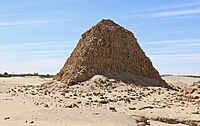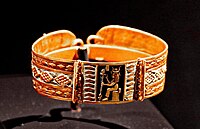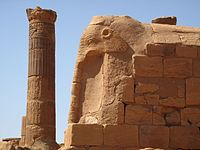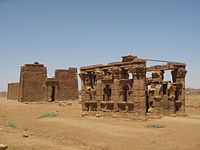Meroë
River Nile, Sudan | |
| Region | Kush |
|---|---|
| Coordinates | 16°56′00″N 33°43′35″E / 16.93333°N 33.72639°E |
| Type | Settlement |
| Official name | Archaeological Sites of the Island of Meroe |
| Type | Cultural |
| Criteria | ii, iii, vi, v |
| Designated | 2011 (35th session) |
| Reference no. | 1336 |
| Region | Africa |
Meroë (
The city of Meroë was on the edge of Butana. There were two other Meroitic cities in Butana: Musawwarat es-Sufra and Naqa.[3][4] The first of these sites was given the name Meroë by the Persian king Cambyses, in honor of his sister who was called by that name. The city had originally borne the ancient appellation Saba, named after the country's original founder.[5] The eponym Saba, or Seba, is named for one of the sons of Cush (see Genesis 10:7). The presence of numerous Meroitic sites within the western Butana region and on the border of Butana proper is significant to the settlement of the core of the developed region. The orientation of these settlements exhibit the exercise of state power over subsistence production.[6]
The Kingdom of Kush which housed the city of Meroë represents one of a series of early states located within the middle Nile. It was one of the earliest and most advanced states found on the African continent. Looking at the specificity of the surrounding early states within the middle Nile, one's understanding of Meroë in combination with the historical developments of other historic states may be enhanced through looking at the development of power relation characteristics within other Nile Valley states.[6]
The site of the city of Meroë is marked by more than two hundred pyramids in three groups, of which many are in ruins. They have the distinctive size and proportions of Nubian pyramids.
History
| ||||||
| mjrwjwꜣt[7] in hieroglyphs | ||||||
|---|---|---|---|---|---|---|

Meroë was the southern capital of the Kingdom of Kush. The Kingdom of Kush spanned the period c. 800 BC – c. 350 AD, initially, its main capital was farther north at Napata.[8] King Aspelta moved the capital to Meroë, considerably farther south than Napata, possibly c. 591 BC,[9] just after the sack of Napata by Egyptian Pharaoh Psamtik II.
First Meroitic Period (542–315 BC)
The Kings ruled over
In the fifth century BC, Greek historian Herodotus described it as "a great city...said to be the mother city of the other Ethiopians."[11][12]
Excavations revealed evidence of important, high ranking Kushite burials from the Napatan Period (c. 800 – c. 280 BC) in the vicinity of the settlement called the Western Cemetery. The importance of the town gradually increased from
-
Jewelry found on the mummy of Nubian King Amaninatakilebte (538–519 BC). Museum of Fine Arts, Boston.
-
Stela of king Siaspiqa (487–468 BC).
-
Portrait of King Nastasen (330–310 BC)
Second Meroitic Period (3rd century BC)
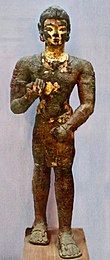
The
Third Meroitic Period (270 BC – 1st century AD)
The
Many artifacts were found in Meroitic tombs from around this time.
-
Pyramids of Meroë - Northern Cemetery
-
Queen Shanakdakhete (170–150 BC)
-
Necklace made of 54 composite human head and ram's head gold pendants with a small carnelian bead between each. Meroitic Period, 270–50 BC
-
Golden Bracelet found in the tomb of a member of the royal family inGebel Barkal. 250–100 BC
-
King Natakamani (early 1st century AD)
Conflict with Rome
Rome's conquest of Egypt led to border skirmishes and incursions by Meroë beyond the Roman borders. In 23 BC, in response to a Nubian attack on southern Egypt, the Roman governor of Egypt, Publius Petronius, invaded Nubia to end the Meroitic raids. He pillaged northern Nubia and sacked Napata (22 BC) before returning home. In retaliation, the Nubians crossed the lower border of Egypt and looted many statues from the Egyptian towns near the first cataract of the Nile at Aswan. Roman forces later reclaimed many of the statues intact, and others were returned following the peace treaty signed in 22 BC between Rome and Meroë under Augustus and Amanirenas, respectively. One looted head, from a statue of the emperor Augustus, was buried under the steps of a temple; it is now kept in the British Museum.[14]

The next recorded contact between Rome and Meroë was in the autumn of 61 AD. The Emperor Nero sent a party of Praetorian soldiers under the command of a tribune and two centurions into this country, who reached the city of Meroë where they were given an escort, then proceeded up the White Nile until they encountered the swamps of the Sudd. This marked the limit of Roman penetration into Africa.[15]
The period following Petronius' punitive expedition is marked by abundant trade finds at sites in Meroë.
Meroë is mentioned briefly in the 1st century AD Periplus of the Erythraean Sea:
2. On the right-hand coast next below Berenice is the country of the Berbers. Along the shore are the Fish-Eaters, living in scattered caves in the narrow valleys. Farther inland are the Berbers, and beyond them the Wild-flesh-Eaters and Calf-Eaters, each tribe governed by its chief; and behind them, farther inland, in the country towards the west, there lies a city called Meroe.
— Periplus of the Erythraean Sea, Chap.2
Fourth Meroitic Period (1st century – 4th century AD)

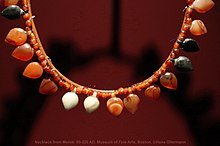
Kings were buried in
A stele of
I, Ezana, King of the Axumites and Himyarites and of Reeidan and of the Sabaites and of Sileel (?) and of Hasa and of the Bougaites and of Taimo...
While some authorities interpret these inscriptions as proof that the Axumites destroyed the Kingdom of Kush, others note that archeological evidence points to an economic and political decline in Meroë around 300.[22]
Meroë in Jewish legend
Jewish oral tradition avers that Moses, in his younger years, had led an Egyptian military expedition into Sudan (Kush), as far as the city of Meroë, which was then called Saba. The city was built near the confluence of two great rivers and was encircled by a formidable wall, and governed by a renegade king. To ensure the safety of his men who traversed that desert country, Moses had invented a stratagem whereby the Egyptian army would carry along with them baskets of sedge, each containing an ibis, only to be released when they approached the enemy's country. The purpose of the birds was to kill the deadly serpents that lay all about that country.[5] Having successfully laid siege to the city, the city was eventually subdued by the betrayal of the king's daughter, who had agreed to deliver the city to Moses on condition that he would consummate a marriage with her, under the solemn assurance of an oath.[a]
Civilization
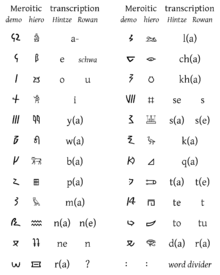
Meroë was the base of a flourishing kingdom whose wealth was centered around a strong
The centralized control of production within the Meroitic empire and distribution of certain crafts and manufactures may have been politically important with their iron industry and pottery crafts gaining the most significant attention. The Meroitic settlements were oriented in a savannah orientation with the varying of permanent and less permanent agricultural settlements can be attributed to the exploitation of rainlands and savannah-oriented forms of subsistence.[6]
At the time, iron was one of the most important metals worldwide, and Meroitic metalworkers were among the best in the world. Meroë also exported
Apart from the iron trade, pottery was a widespread and prominent industry in the Meroë kingdom. The production of fine and elaborately decorated wares was a strong tradition within the middle Nile. Such productions carried considerable social significance and are believed to be involved in mortuary rites. The long history of goods imported into the Meroitic empire and their subsequent distribution provides insight into the social and political workings of the Meroitic state. The major determinant of production was attributed to the availability of labor rather than the political power associated with land. Power was associated with control of people rather than control of territory.[6]
The
At its peak, the rulers of Meroë controlled the Nile Valley north to south, over a straight-line distance of more than 1,000 km (620 mi).[27]
The King of Meroë was an autocratic ruler who shared his authority only with the Queen Mother, or
Although the people of Meroë also had southern deities such as
The collapse of their external trade with other Nile Valley states may be considered one of the prime causes of the decline of royal power and disintegration of the Meroitic state in the 3rd and 4th centuries AD.[6]
Language

The
By the 3rd century BC, a new indigenous
It is uncertain to which language family the Meroitic language is related. Kirsty Rowan suggests that Meroitic, like the Egyptian language, belongs to the Afro-Asiatic family. She bases this on its sound inventory and phonotactics, which, she proposes, are similar to those of the Afro-Asiatic languages and dissimilar from those of the Nilo-Saharan languages.[30][31] Claude Rilly, based on its syntax, morphology, and known vocabulary, proposes that Meroitic, like the Nobiin language, instead belongs to the Eastern Sudanic branch of the Nilo-Saharan family.[32][33][34]
Archaeology
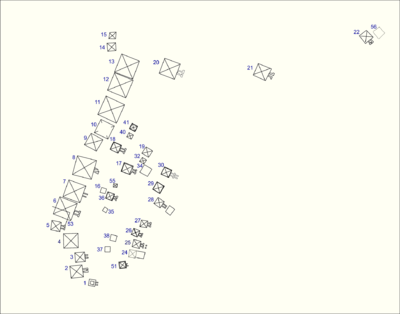
The site of Meroë was brought to the knowledge of Europeans in 1821 by the French mineralogist Frédéric Cailliaud (1787–1869), who published an illustrated in-folio describing the ruins. His work included the first publication of the southernmost known Latin inscription.[b]
As Margoliouth notes in the 1911 Encyclopedia Britannica, small scale excavations occurred in 1834, led by Giuseppe Ferlini,[2] who, as Margoliouth states, "discovered (or professed to discover) various antiquities, chiefly in the form of jewelry, now in the museums of Berlin and Munich."[2] Margoliouth continues,
The ruins were examined in 1844 by
reliefs were taken down stone by stone in 1905, and set up partly in the British Museum and partly in the museum at Khartoum. In 1910, in consequence of a report by Professor Archibald Sayce, excavations were commenced in the mounds of the town and the necropolis by J[ohn] Garstang on behalf of the University of Liverpool, and the ruins of a palace and several temples were discovered, built by the Meroite kings.[2]
-
Column and elephant - part of temple complex in Musawwarat es-Sufra
-
Roman Kiosk and Apedemak Temple in Naqa
-
Colonnade of rams in front of Amun-Ra temple in Naqa
World Heritage listing

In June 2011, the Archeological Sites of Meroë were listed by UNESCO as World Heritage Sites.[3]
See also
References
Notes
- Gedaliah ibn Yahya's Shalshelet Ha-Kabbalah, Jerusalem 1962, p. 22 (p. 31 in PDF) (Hebrew); Pseudo-Jonathan – the Aramaic Targum of pseudo-Jonathan ben Uziel (ed. Dr. M. Ginsburger), 2nd edition, Jerusalem 1974, p. 248.
- ^ CIL III, 83. This inscription was subsequently published by Lepsius, who brought the stone back to Berlin. Although thought lost, it was recently rediscovered in the Skulpturensammlung und Museum für Byzantinische Kunst of the Staatliche Museen in Berlin[35]
Citations
- ^ "Meroë" in the American Heritage Dictionary of the English Language (2020).
- ^ a b c d Margoliouth, David Samuel (1911). . In Chisholm, Hugh (ed.). Encyclopædia Britannica. Vol. 18 (11th ed.). Cambridge University Press. p. 172.
- ^ a b "Archaeological Sites of the Island of Meroe". UNESCO World Heritage Centre. United Nations Educational, Scientific and Cultural Organization (UNESCO). Retrieved 15 March 2020.
- ^ Elkhair, Osman; Ali, Imad-eldin. "Ancient Meroe Site: Naqa and Musawwarat es-Sufra". Ancient Sudan–Kush. Ancientsudan.org. Archived from the original on 5 May 2006. Retrieved 6 September 2012.
{{cite web}}: CS1 maint: unfit URL (link) - ^ a b Josephus, Titus Flavius, Antiquities of the Jews, Book 2, Chapter 10, Section 2, Paragraphs 245–247 and 249, archived from the original on 22 May 2020, retrieved 19 February 2017
- ^ S2CID 55376329.
- ^ Gauthier, Henri (1926). Dictionnaire des Noms Géographiques Contenus dans les Textes Hiéroglyphiques. Vol. 3. p. 12.
- ISBN 90-04-10448-8.
- ISBN 978-0-8191-7941-8. Retrieved 17 March 2011.
- ^ a b c d Dows Dunham, Notes on the History of Kush 850 B. C. – A. D. 350, American Journal of Archaeology, Vol. 50, No. 3 (July – September , 1946), pp. 378–388
- ^ Herodotus (1949). Herodotus. Translated by J. Enoch Powell. Translated by Enoch Powell. Oxford: Clarendon Press. pp. 121–122.
- ISBN 978-0-521-26666-6.
- ^ George A. Reisner, The Pyramids of Meroë and the Candaces of Ethiopia, Museum of Fine Arts Bulletin, Vol. 21, No. 124 (Apr., 1923), pp. 11–27
- ^ "Bronze head of Augustus". British Museum. 1999. Archived from the original on 10 February 2008. Retrieved 14 June 2008.
- ^ JSTOR 1790717.
- ^ "Nubia". BBC World Service. British Broadcasting Corporation. Retrieved 6 September 2012.
- ISBN 978-1-000-74090-5.
- ^ ISBN 978-1-4412-4571-7.
- ^ .|quote=Moi, Ézana, roi des Axoumites, des Himyarites, de Reeidan, des Sabéens, de S[il]éel, de Kasô, des Bedja et de Tiamô, Bisi Alêne, fils de Elle-Amida et serviteur du Christ
- ISBN 9781108057820.
- ISBN 978-80-268-5034-2.
- ISBN 978-0-7486-0106-6.
- ^ Stofferahn, Steven; Wood, Sarah (2016) [2003], Rauh, Nicholas K. (ed.), Lecture 30: Ancient Africa [CLCS 181: Classical World Civilizations] (student lecture notes), West Lafayette, IN: Purdue University, School of Languages and Cultures, retrieved 28 February 2017
- ISSN 0093-4690.
- ^ ISBN 0435948059– via UNESCO.
- ISBN 978-1-884964-03-9.
- ISBN 978-0-691-09370-3.
- ISBN 1861895887.
- ^ ""Meroe: Writing", Digital Egypt, University College, London". Digitalegypt.ucl.ac.uk. Retrieved 6 September 2012.
- ^ Rowan, Kirsty (2011). "Meroitic Consonant and Vowel Patterning". Lingua Aegytia. 19 (19): 115–124.
- ^ Rowan, Kirsty (2006). "Meroitic – An Afroasiatic Language?" (PDF). SOAS Working Papers in Linguistics (14): 169–206. Archived from the original (PDF) on 27 December 2015. Retrieved 24 December 2014.
- ISBN 978-1-107-00866-3.
- ^ Rilly, Claude (March 2004). "The Linguistic Position of Meroitic" (PDF). ARKAMANI: Sudan Electronic Journal of Archaeology and Anthropology. Archived from the original (PDF) on 23 September 2015. Retrieved 24 December 2014.
- ^ Rilly, Claude (June 2016). "Meroitic". In Stauder-Porchet, Julie; Stauder, Andréas; Wendrich, Willeke (eds.). UCLA Encyclopedia of Egyptology. Los Angeles: University of California, Los Angeles (UCLA).
- JSTOR 20191127.
- ^ Budge, E. A. Wallis (1907). The Egyptian Sudan, its history and monuments. Vol. 2 (1st ed.). London: Kegan, Paul, Trench, Trübner & Co.
Further reading
- Bianchi, Steven (1994). The Nubians: People of the ancient Nile. Brookfield, Conn.: Millbrook Press. ISBN 1-56294-356-1.
- Davidson, Basil (1966). Africa, History of A Continent. London: Weidenfeld & Nicolson. pp. 41–58.
- Shinnie, P. L. (1967). Meroe, a civilization of Sudan. Ancient People and Places. Vol. 55. London/New York: Thames and Hudson.
External links
 Media related to Meroë at Wikimedia Commons
Media related to Meroë at Wikimedia Commons- LearningSites.com – Gebel Barkal
- UNESCO World Heritage – Gebel Barkal and the Sites of the Napatan Region
- Nubia Museum – Meroitic Empire
- Voyage au pays des pharaons noirs Travel in Sudan and notes on Nubian history (in French)
- Labelled map of the pyramids at Meroe
- Sudan's forgotten pyramids – BBC News
- Pictures of Meroë – An online slide show as part of a detailed travelogue (in German)

